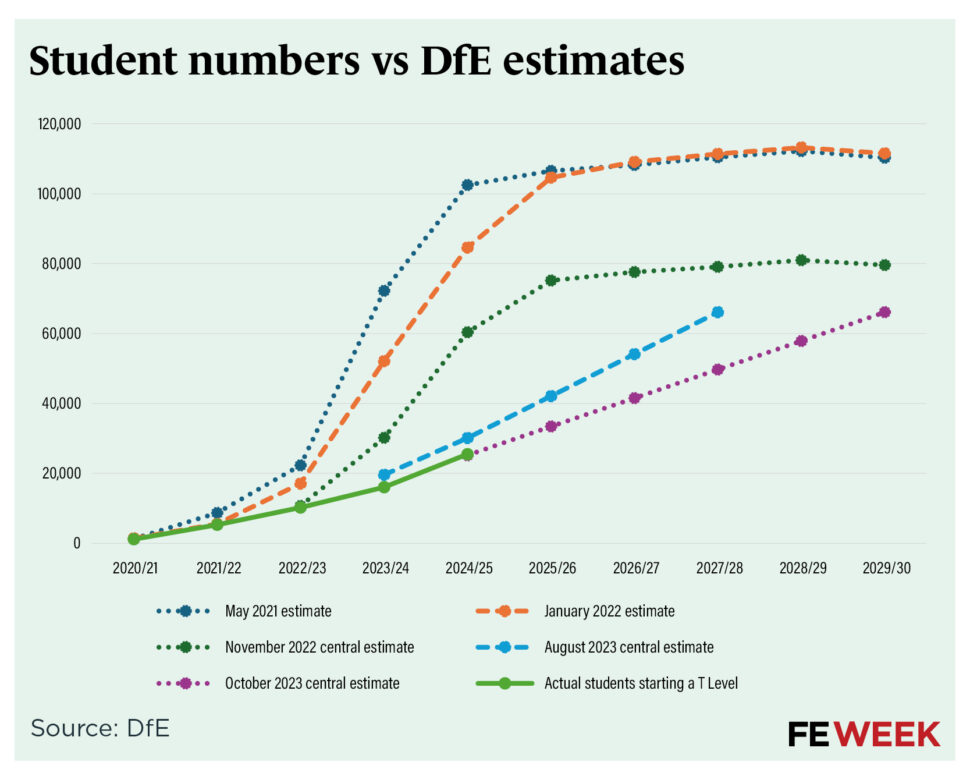The UK’s spending watchdog has cast doubt on the scalability of T Levels after finding student number forecasts were missed by three quarters – resulting in a near-£700 million spending shortfall.
MPs today warned the Department for Education it had “much to do” to convince people of T Levels’ “worth as a desirable and valuable” qualification after a National Audit Office (NAO) report revealed starts this year were 75 per cent below an initial target of 102,500.
The independent body highlighted “significant risks” to expanding T Levels after revealing secret DfE estimates that show places could be limited to just 48,000 due to teacher and employer “capacity constraints”, and that there may be 6,500 learners unable to find industry placements in 2027-28.
It is the first time any DfE modelling and projections on T Levels have been put into the public domain.
The NAO told the DfE to develop “ways to understand the potential impacts on the demand, benefits and cost of T Levels” before it makes “wider strategic decisions” around the development of the technical qualifications landscape, amid plans to defund competing courses like BTECs.
The DfE’s calculations on assumed student numbers have been “inaccurate” and “lacked transparency”, the NAO said, causing financial losses to awarding organisations delivering the so-called “gold standard” qualification.
Sir Geoffrey Clifton-Brown, chair of the Public Accounts Committee, said a lack of widespread awareness, declining pass rates and challenges securing industry placements show a risk to the DfE’s “ability” to scale up T Levels.
“For T Levels to be a success, the department has much to do to convince students and providers of their worth as a desirable and valuable qualification,” he added.
Bill Watkin, chief executive of the Sixth Form Colleges Association, said: “Today’s report is clear that the Department for Education cannot yet measure whether T Levels are achieving their aims. Until it can, we believe the department should change its current policy to allow medium and large applied general qualifications to co-exist with T Levels.”
The DfE doubled down on its “clear commitment” to T Levels, designed to be the technical equivalent to A-levels.
A spokesperson said: “T Levels continue to grow, with nearly 60 per cent more young people taking them last year than in the previous year. Based on employer-designed standards and with a substantial industry placement on every course, T Levels will be important contributors to our mission to grow the economy.”
Targets missed to the tune of £688m
The DfE has always claimed it never set student number targets for T Levels. However, the department told the NAO it does hold forecasts.
In June 2021, the DfE set a figure of 100,000 enrolments by September 2025 but has now revised this down to 49,700 by September 2027.
In 2020, the first year of delivery, the number of starts almost met the 1,300 prediction, missing by 10 per cent, but the gap has since widened every year.
In 2023-24, 16,081 starts were recorded, 78 per cent lower than an original forecast of 72,200.
Student starts in 2024-25 rose to 25,508, but based on original 2021 estimates given to the NAO, the DfE believed 102,500 students would start a T Level this year.

The DfE had an original budget of £1.94 billion to spend on T Levels up to the end of 2024-25, but it has only spent £1.25 billion, as revealed by FE Week earlier this week.
It means the DfE underspent £688 million due to low student take-up.
Underspends are usually returned to the Treasury but can sometimes be reallocated to wider education priorities, the DfE said.
The NAO said the department has “not yet estimated how much T Levels will cost beyond March 2025” given the upcoming spending review.
Of the 16 T Levels that launched by September 2022, the NAO found actual student starts were lower than the DfE’s assumed numbers in all but one subject.
DfE estimates were used by awarding organisations to inform their pricing.
For T Levels such as digital business services, numbers were 98 per cent lower than the 4,500 predicted. Even popular courses like the education and early years T Level missed a 6,500 forecast by 35 per cent.
Awarding organisations told the NAO that the Institute for Apprenticeships and Technical Education (IfATE), the quango tasked with rolling out T Levels, “lacked transparency” in sharing information on student numbers.
“Two awarding organisations told us they could not challenge the assumptions. Awarding organisations were locked into the prices they had set throughout the contract,” the report said.
The report found across seven contracts IfATE recently retendered, which include a new “adaptive pricing” feature, that fees payable by providers for T Level students will shoot up by between 26 per cent and 243 per cent.
And it revealed the government had struggled to convince awarding bodies to get involved in T Levels, stating that IfATE considered low student numbers, the brief announcement of the Advanced British Standard which would have replaced T Levels but has now been ditched, and “delays defunding larger overlapping qualifications” had “affected market interest in T Levels”.
Secret limit on available places
The NAO report revealed the DfE has doubts about its ability to increase student numbers and had estimated in August 2023 that the number of T Level places could be limited to around 48,000 because of “constraints imposed by shortages of teachers and industry placements”.
The department told the NAO that “any estimate of the future capacity of the system to support students was uncertain”.
“[DfE] told us that it has limited evidence regarding teachers’ availability and whether teachers would prioritise teaching T Levels over other qualifications,” the report said.
“It also estimated available industry placements based on what employers could theoretically offer, with limited data to estimate constraints across different T Levels or geographical areas.”
The DfE has not updated this estimate but has “continued to use it in its internal reporting”.
The report also revealed that the DfE estimated in 2023 there could be around 6,500 students per year without an industry placement in 2027/28.
Industry placements of at least 45 days are a mandatory component of T Levels. The sector had warned from the outset there would not be enough employers to offer placements when the qualifications were fully rolled out.
The NAO report added the DfE now expects to achieve “steady state” in September 2029, when all T Levels have been rolled out and overlapping qualifications are defunded.
“Based on its latest model, DfE’s central estimate is for 49,700 students in September 2027, and 66,100 in September 2029, with upper estimates of 60,000 and 80,000 respectively,” the report added.
Despite there not being any student earnings data yet on T Levels, the DfE told the NAO its “best judgment” is that T Levels will be “25 per cent more valuable (around £23,000 per student over their lifetime, in 2019-20 prices)” than other level 3 qualifications.
Pass rates on the qualifications are around 90 per cent but almost a third of students drop out before completing their course.
Gareth Davies, head of the NAO, said: “Although the Department for Education has made progress in delivering the wide range of courses available, efforts must be made to increase student numbers and realise all the potential benefits of T Levels.”













So frustrating, federation of small business and small businesses across the country have been saying this since ESF got cancelled over a year ago and they are just being ignored. You are not going to get anything like enough placements if your strategy is to freeload of business for them , small business just won’t put up with it.
People thought they didn’t have the money but they clearly do have the funding to do this, it is really bad policy decisions that have resulted in these placement shortfalls.
Reinstate a fully funded and improved version of the T level Employer Support Fund now to get these qualifications back on track.
Lets hope they know that measuring enrolments and individuals will give different figures, depending on the time periods being applied in measuring.
This could just be loosely interpreted and poorly used terminology in the article, but if it’s happening at DfE level, then there could be double counting going on.
An interesting element is the survey the Department of Education took last year for T level industry placements. We got it in the summer last year. On the DofE T level website they use it as the justification for stopping the T level placement funding, the majority of firms don’t need the funding they say. BUT this survey was not conducted by a professional polling firm, no weighting was used on this survey, no account taken for those who did not answer, no split between, small, medium or large businesses, they didn’t even ask you this question on the survey, no polling techniques used to allow for the complicated answers given and no professional polling analysis done by any leading polling company.
Yet this very questionable and completely unreliable survey has been used to determine the entire policy towards T levels industry placement subsidy.
A Very regrettable outcome.
The cost is ridiculous. The civil servants involved are culpable but they are never held to account. The country is in financial meltdown with suggestions that the in year funding regime will be tightened yet the waste and failure is plain to see. Massaging stats ….noone talks about pass rates yet everywhere else it’s achievement rates. 30 per cent drop out or non completion. This is a waste of public money. Face up to the reality the btecs offer better options. These could have been amended to yield some of the t level outcomes. The obvious question that’s neve been answered why do t levels if you are capable of doing a levels. You can still be a plumber with a levels but t levels will not gain the acceptance at many unis, and it goes against the intent which was they are a pathway to work. T levels answered the wrong questions thanks to Sainsbury and Wolf cloistered view of the real world, amply aided by compliant civil servants.
As one of many lecturers currently delivering BTECs – a highly-regarded and effective qualification – I have, from first hearing about the Government’s intention to replace BTECs with T Levels, been skeptical about the entire concept. As time passes, it is becoming more obvious that this is a badly-thought out, ill-planned, and ridiculous decision. T Levels are doomed and will fail, it is clear to see if only from the consideration of the mandatory work placement element. For example, expecting IT students to secure a place in IT in the North East is impossible when there are very few opportunities for short-term placements to begin with, and the incentive for employers is virtually non-existent, despite claims that employers were extensively consulted beforehand. Having also taught on a business-related T Level, I have first-hand experience of the process and demands (with poor quality resources from awarding bodies where they do exist), and the difficulties of engaging employers. T Levels need to be scrapped before any more public money is squandered, and BTECs maintained until a viable and realistic alternative (with genuine consultations of all stakeholders) can be initiated.